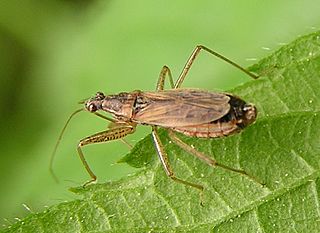Zeluroides is a genus of assassin bugs in the family Reduviidae. There are at least two described species in Zeluroides.

Oncocephalus is a genus of assassin bugs in the family Reduviidae. There are at least 210 described species in Oncocephalus.

Acompocoris is a genus of minute pirate bugs in the family Anthocoridae. There are at least four described species in Acompocoris.
Myrmedobia is a genus of minute bladder bugs in the family Microphysidae. There are about five described species in Myrmedobia.
Elatophilus is a genus of minute pirate bugs in the family Anthocoridae. There are about 15 described species in Elatophilus.

Hoplistoscelis is a genus of damsel bugs in the family Nabidae. There are about eight described species in Hoplistoscelis.
Temnostethus is a genus of minute pirate bugs in the family Anthocoridae. There are about eight described species in Temnostethus.
Mallochiola is a genus of minute bladder bugs in the family Microphysidae. There is one described species in Mallochiola, M. gagates.
Phorticus is a genus of damsel bugs in the family Nabidae. There are about eight described species in Phorticus.
Vatiga is a genus of lace bugs in the family Tingidae. There are about 11 described species in Vatiga.
Minitingis is a genus of lace bugs in the family Tingidae. There are at least two described species in Minitingis.
Coccivora is a genus of minute pirate bugs in the family Anthocoridae. There is one described species in Coccivora, C. californica.
Metatropiphorus is a genus of damsel bugs in the family Nabidae. There are at least four described species in Metatropiphorus.
Cimexopsis is a genus of bed bugs in the family Cimicidae. There is one described species in Cimexopsis, C. nyctalis.
Spanagonicus is a genus of plant bugs in the family Miridae. There are about five described species in Spanagonicus.
Melanocoris is a genus of minute pirate bugs in the family Anthocoridae. There are at least four described species in Melanocoris.
Rocconota is a genus of assassin bugs in the family Reduviidae. There are about 10 described species in Rocconota.
Lopidella is a genus of plant bugs in the family Miridae. There are about five described species in Lopidella.
Hesperocimex is a genus of bed bugs in the family Cimicidae. There are at least two described species in Hesperocimex.




